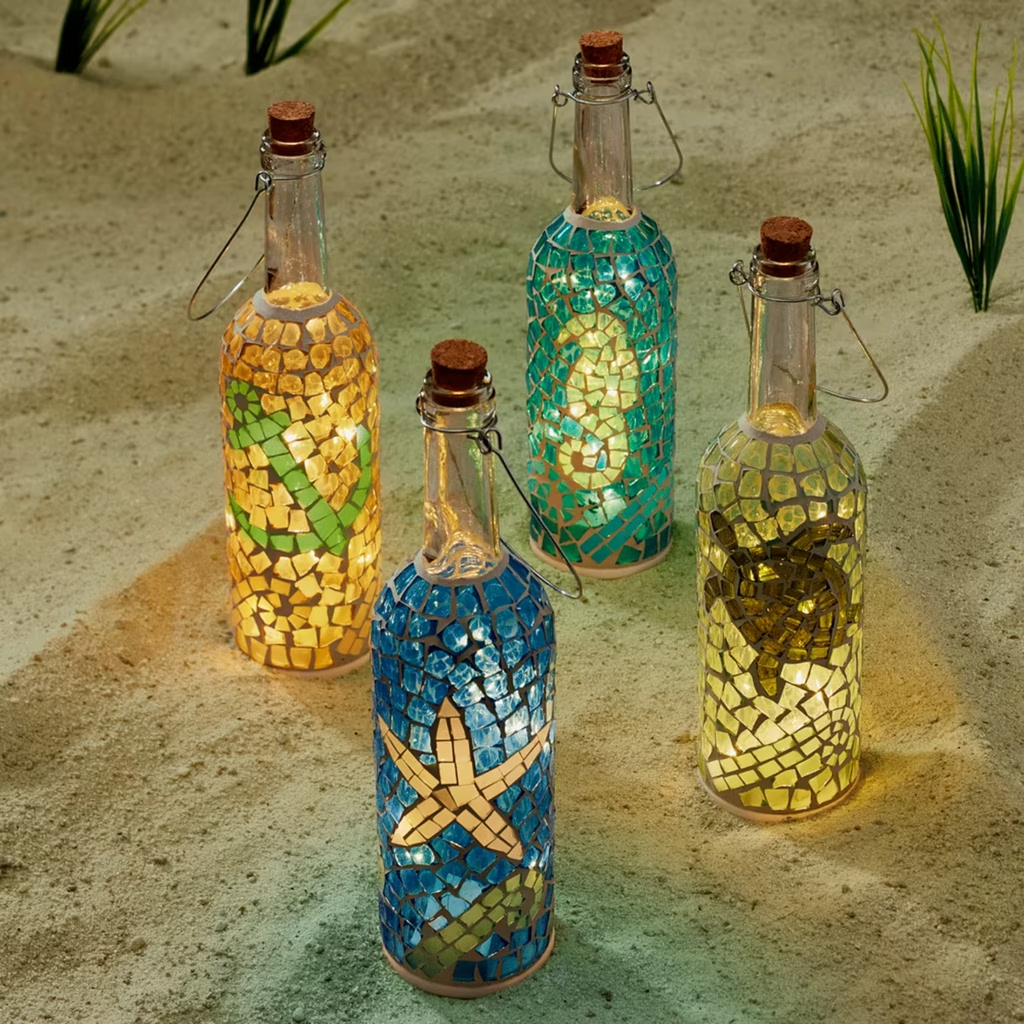Carménère is a red wine that originated in Bordeaux, France, and is often referred to as a “lost grape” of the region. The Carménère grape is used both as a blending grape in Bordeaux’s renowned red wines and to produce single-varietal wines. This wine is highly valued for its supple red and black berry flavors, which are reminiscent of Merlot, along with its herbaceous notes of green peppercorn.
Ocean Mosaics Wine Bottle Lanterns
A Wine Enthusiast exclusive | Ocean Mosaics Wine Bottle Lanterns (Set Of 4)
Key Features
- A Wine Enthusiast exclusive
- Each lantern handcrafted with a unique ocean-themed mosaic design: turtle, anchor, starfish, seahorse
- Includes LED fairy lights for a gorgeous glow (batteries not included)
- Metal hanger tops allow versatile styling, indoors and out
- Dimensions: 11” H
Ocean Mosaics Wine Bottle Lanterns

Today, finding Carménère wines in France is nearly impossible. In 1867, the phylloxera plague devastated vineyards across Europe, including those growing Carménère grapes, leading to the belief that it had become extinct for many years. When vineyards were replanted after the plague, growers faced difficulties in replanting Carménère due to its rarity and the challenges associated with cultivating it compared to other, more familiar grape varieties in Bordeaux.

The devastation caused by phylloxera in Europe led many French winemakers to explore new regions for wine production. This shift resulted in the flourishing of viticulture in Chile, where cuttings from European vines were imported and cultivated for personal and local consumption.
In the 1990s, Chilean wines gained significant attention, primarily due to high demand in the UK and Germany. These wines were not only easy to drink but also budget-friendly, making them popular in supermarkets. Cuttings of Cabernet Sauvignon, Merlot, Cabernet Franc, Malbec, Sauvignon Blanc, and Semillon were brought to Chile to produce Bordeaux-style wines, which turned out to be quite successful.
Insulated 2-Bottle Wine Picnic Cooler Bag

Key Features
- Generously sized cooler holds two bottles of wine, hot/cold foods and picnic accessories
- Insulated center compartment for casserole dishes, cheese boards; side pocket fits two standard wine bottles
- Front zip storage with pockets for napkins, flatware, plates, and accessories
- 100% cotton canvas; two-way zip closures
- Dimensions: 11”L x 11”W x 13”H
Generously sized cooler holds two bottles of wine, hot/cold foods and picnic accessories | Insulated 2-Bottle Wine Picnic Cooler Bag
Picnic Cooler Bag
The grape
Carménère is a grape variety that can be challenging to cultivate. It ripens late and requires abundant sunshine and warm summers to reach its full potential. When grown under ideal conditions, Carménère can produce deep-colored red wines with robust flavors. This is why the grape flourishes particularly well in Chile, especially in wine regions that enjoy a Mediterranean climate, characterized by long, sunny days and cool evenings during the growing season.



Casas Del Bosque Carmenère Reserva
Terranoble Gran Reserva Carmenere
Santa Rita Carmenere
In 1997, Chilean Merlot gained attention when French scientists questioned its authenticity, appearance, and character. After thorough investigation and experimentation, it was officially identified as the old Bordeaux varietal Carménère, a grape that had nearly disappeared from France. Today, Carménère has become Chile’s signature grape, celebrated for producing high-quality wines.

These grapes produce a relatively bold, fruity wine of deep violet color. Best enjoyed young, Carménère is very smooth with a medium body, well-rounded tannin, and medium-high acidity. You will find several different styles and structures depending on the regions or valleys where the wine is produced. A majority of carménère vines are planted in Chile’s Colchagua Valley, part of the Rapel Valley wine region in the country’s center, with some planted in the Maipo Valley near Santiago. The best sub-regions for carménère are Apalta and Los Lingues, in the Colchagua valley. Chilean winemakers make a range of wines, from easy-drinking, inexpensive bottles to premium oak-aged examples, like Purple Angel from Montes, that receive notice from global critics.



Natura Carmenere
Araucano – Alka Carmenere
Marques de Casa Concha Carmenere
Wine Enthusiast Brilliance! Shatterproof Tritan Outdoor Wine Glasses (Clear or Assorted Color) (Set of 6)

Universal glasses made from impact-resistant BPA-free Eastman Tritan⢠copolyester | Brilliance! Shatterproof Tritan Outdoor Wine Glasses (Set Of 6) – Clear by Wine Enthusiast
Key Features
- Universal glasses made from impact-resistant BPA-free Eastman Tritan™ copolyester
- Offers the elegant style and clarity of crystal glass without the worry of shattering
- Easy-care: won’t break, scratch, crack or cloud and dishwasher safe
- Available in clear and assorted colors
- Dimensions: 8”H; Capacity: 15 oz.
Wine Enthusiast Brilliance! Shatterproof Tritan Outdoor Wine Glasses
Description & pairing
Carménère is a medium-bodied wine that has a distinct personality. It offers a mix of red and black fruit notes, along with spice, smokiness, and herbal undertones. You’ll find robust flavors of plums, berries, cocoa, bell pepper, jalapeños, coffee, and chocolate. This wine pairs excellently with dishes such as beef empanadas, BBQ, and grilled red meats, as well as mushroom pizza and vegetable quiche. Its lower tannin content makes Carménère a suitable choice for lighter, less fatty dishes as well.

A perfect pairing for Carménère
Green Pepper, Onion and Mushroom Pizza
- 2 green peppers thinly slice and chopped (mix with red peppers is optional)
- 1 cup of sliced mushrooms
- 1 large yellow onion, sliced
- 1 can reduced or regular stewed tomatoes
- 1 teaspoon garlic powder
- 1 tablespoon tomato paste
- 1/2 cup Olives (optional)
- 1 cup Sausage (optional)
- 2 1/2 teaspoons of fresh sage or 1 teaspoon of dried sage
- 3/4 teaspoon fresh or dried Basil
- 1/2 teaspoon dried oregano
- 1/2 cup Mozzarella cheese
- 1 cup parmesan Reggiano
- 1 package of refrigerated pizza dough or pita or Naan Flatbread
Combine onions, peppers, mushrooms, your choice of spices, stewed tomatoes, and tomato paste in a large skillet. On medium-high heat, bring the mixture to a simmer, stirring occasionally, and cover for 10 minutes. After 10 minutes, uncover and let it cook for an additional 5 minutes to allow the sauce to thicken. Once thickened, set the sauce aside to cool.
Next, preheat the oven to 450°F (232°C) and lightly spray a 12-inch pizza pan with nonstick cooking spray. Roll out the pizza dough on a lightly floured surface, making sure to roll it an additional inch for the crust. Place the dough onto the pizza pan and bake for 10 minutes. After removing the crust from the oven, spread the sauce evenly on top, and sprinkle your chosen toppings over the sauce. Return the pizza to the oven and bake for another 10 to 12 minutes.
If you are using pita or naan flatbreads instead, preheat the oven to 375°F (190°C). Lightly brush olive oil on both sides of the bread. Spread the sauce on top, then add cheese and toppings. Bake for 5 to 7 minutes, and enjoy with a glass of Carménère! For meat lovers, ground turkey can be used as an option.
PREP:10 minutes- Cook Sauce: 8 minutes-Bake at 450, 22 minutes

Indoor/Outdoor Iron Wine Bottle Wall Clock

Indoor/outdoor wall clock with 12 unique wine bottle designs Indoor/outdoor Iron Wine Bottle Wall Clock by Wine Enthusiast.
Key Features
- Indoor/outdoor wall clock with 12 unique wine bottle designs
- Crafted from iron and hand-painted in an array of rich lustrous colors
- Finished in anti-rust coating for outdoor use
- Dimensions: 32” Dia.
Indoor/Outdoor Iron Wine Bottle Wall Clock
This page contains affiliate links. If you choose to purchase after clicking a link, I may receive a commission at no additional cost to you. Thank you for your support!

